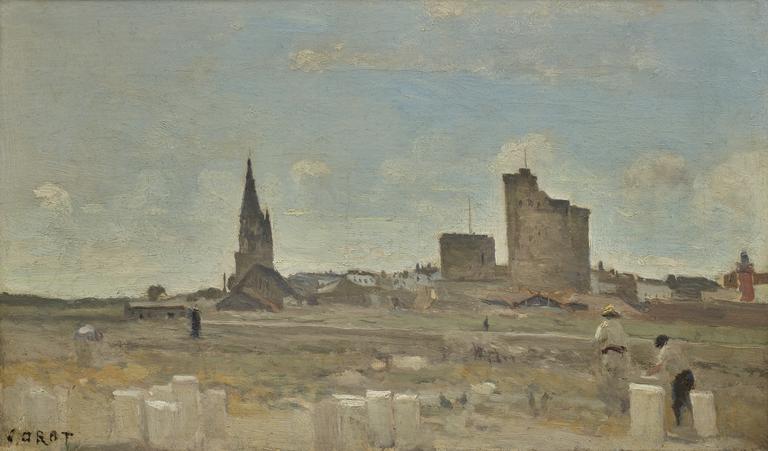
La Rochelle - Carriers près de l'entrée du port
Jean-Baptiste Camille Corot (1796 Paris - 1875 Paris)
1851
Huile sur toile ; signé « COROT » en bas à gauche ; 22 x 36,5 cm
Provenance :
Paris, Hôtel Drouot, 1875 (titré La Rochelle. Les tours à l'entrée du port ; au premier plan des tailleurs de pierres) ; Paris, Galerie Hector Brame ; Paris, Galerie Julien Tempelaere, Paris (en 1876) ; Londres, collection O’Bach & Co. (vers 1900) ; Glasgow, collection Thomas Glen Arthur, (en 1902) ; Londres, Christie’s, 20 mars 1914 (titré Vue de La Rochelle: les tailleurs de pierres) ; Glasgow, Alex Reid Gallery ; Paris, Galerie Julien Tempelaere (en 1914) ; Paris, collection Ernest May (en 1914) ; Paris, collection Jacques Ernest May ; Santa Barbara, collection Stephen Hahn ; New York, Sotheby’s, 13 mai 1997 ; Collection privée ; New York, Christie’s, 30 avril 2019.
Exposition :
Exposition d'œuvres de Corot, Paysages de France et Figures (Paris, Galerie Paul Rosenberg, 1930, n° 23) ; Le Divin Corot (Paris, Galerie Alfred Daber, 1951, n° 15, reproduit, titré Vue de La Rochelle, les tailleurs de pierres) ; Santa Barbara Museum of Art (Santa Barbara Museum of Art, en prêt à partir de 1991).
Bibliographie :
Alfred Robaut, L'Œuvre de Corot. Catalogue raisonné et illustré, vol. II, Paris, Henri Floury, 1905, pp. 232-233, n° 673 (reproduit).
Les vues de La Rochelle peuvent être précisément datées, puisque Corot n’y passa qu’une fois, 3 semaines, en août 1851. Il en rapporta, écrit son collectionneur et biographe Etienne Moreau-Nélaton (Corot raconté par lui-même, Paris, 1924), « une demi-douzaine de petits chefs-d’œuvre » : le plus connu (et le plus grand) est aujourd’hui à la Yale University Art Gallery, les autres sont plus petits, tout aussi lumineux mais d’une facture plus libre. Moreau-Nélaton lui-même donna au Musée du Louvre, en 1906, La Rochelle, entrée du port d’échouage.
On reconnaît ici, de gauche à droite, la tour de la Lanterne, puis la tour de la Chaîne et la tour Saint-Nicolas qui encadrent l’entrée du port ; vues depuis le quartier du Gabut, à l’époque un terrain vague encore, enserré entre l’enceinte de la vieille ville et le bassin des chalutiers, entrepris en 1807 et achevé en 1862. Ce bassin est donc derrière le spectateur, et le chenal qui mène du vieux port à l’océan passe devant la tour de la Lanterne.
La luminosité, la même qu’on retrouve un siècle plus tard chez Nicolas de Staël, est proprement éblouissante, accentuée par les touches de blanc pur qui couronnent les blocs de pierre. La facture est rapide, avec des empâtements généreux qu’a su préserver un rentoilage ancien.
On sent le soleil et la brise légère, on devine l’enthousiasme du peintre devant un motif qu’il découvre et enrichit des signes de l’activité humaine. On aurait aimé entendre, quelques minutes auparavant, l’échange entre les carriers et Corot installant son chevalet...
Cette qualité particulière, qui rappelle les années italiennes du peintre tout en préparant la venue de l’impressionnisme, a séduit successivement Ernest May, grand banquier et collectionneur qu’immortalisa Degas dans Portraits à la Bourse, aujourd’hui au Musée d’Orsay ; et Stephen Hahn, un des plus grands marchands américains, en même temps que collectionneur, de la seconde moitié du 20ème siècle, à l’œil éclectique puisqu’il fut un des premiers à défendre Dubuffet...
